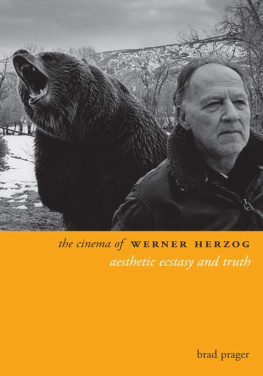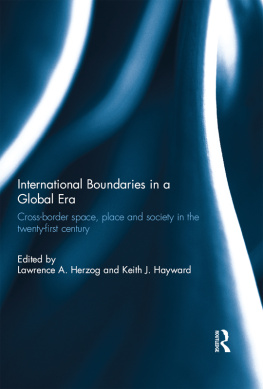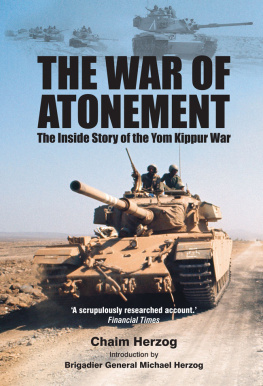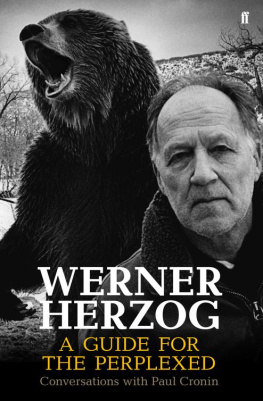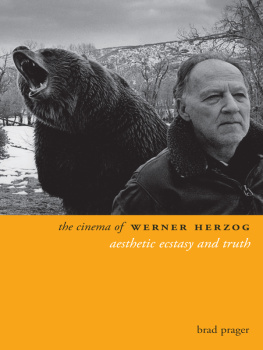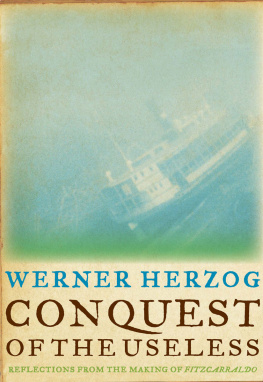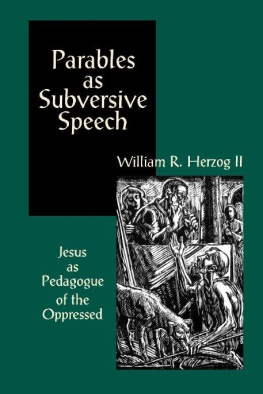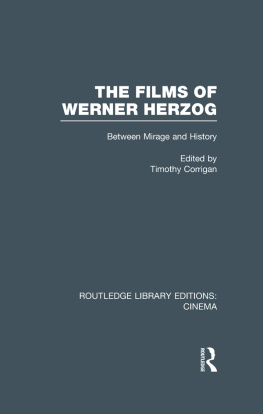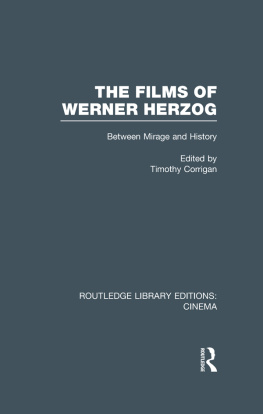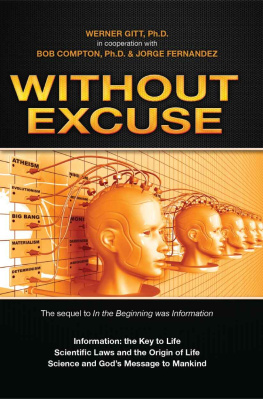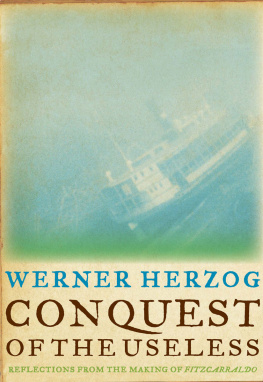the cinema of WERNER HERZOG
DIRECTORS CUTS
Other titles in the Directors Cuts series:
the cinema of EMIR KUSTURICA: notes from the underground
GORAN GOCIC
the cinema of KEN LOACH: art in the service of the people
JACOB LEIGH
the cinema of WIM WENDERS: the celluloid highway
ALEXANDER GRAF
the cinema of KATHRYN BIGELOW: hollywood transgressor
edited by DEBORAH JERMYN & SEAN REDMOND
the cinema of ROBERT LEPAGE: the poetics of memory
ALEKSANDAR DUNDJEROVIC
the cinema of GEORGE A. ROMERO: knight of the living dead
TONY WILLIAMS
the cinema of TERRENCE MALICK: poetic visions of america
edited by HANNAH PATTERSON
the cinema of ANDRZEJ WAJDA: the art of irony and defiance
edited by JOHN ORR & ELZBIETA OSTROWSKA
the cinema of KRZYSZTOF KIESLOWSKI: variations on destiny and chance
MAREK HALTOF
the cinema of DAVID LYNCH: american dreams, nightmare visions
edited by ERICA SHEEN & ANNETTE DAVISON
the cinema of NANNI MORETTI: dreams and diaries
edited by EWA MAZIERSKA & LAURA RASCAROLI
the cinema of MIKE LEIGH: a sense of the real
GARRY WATSON
the cinema of JOHN CARPENTER: the technique of terror
edited by IAN CONRICH AND DAVID WOODS
the cinema of ROMAN POLANSKI: dark spaces of the world
edited by JOHN ORR & ELZBIETA OSTROWSKA
the cinema of TODD HAYNES: all that heaven allows
edited by JAMES MORRISON
the cinema of STEVEN SPIELBERG: empire of light
NIGEL MORRIS
the cinema of ANG LEE: the other side of the screen
WHITNEY CROTHERS DILLEY
the cinema of LARS VON TRIER: authenticity and artifice
CAROLINE BAINBRIDGE
the cinema of NEIL JORDAN: dark carnival
CAROLE ZUCKER
the cinema of
WERNER HERZOG
aesthetic ecstasy and truth
brad prager
| WALLFLOWER PRESS LONDON & NEW YORK |
A Wallflower Press Book
Published by Columbia University Press
Publishers Since 1893
New York
cup.columbia.edu
Reprinted 2011
Copyright Brad Prager 2007
All rights reserved.
E-ISBN 978-0-231-50213-9
Wallflower Press is a registered trademark of Columbia University Press.
A complete CIP record is available from the Library of Congress
ISBN 978-1-905674-18-3 (cloth)
ISBN 978-1-905674-17-6 (cloth)
ISBN 978-0-231-50213-9 (e-book)
A Columbia University Press E-book.
CUP would be pleased to hear about your reading experience with this e-book at .
CONTENTS
This book has been a pleasure to write, not only because it has afforded me the opportunity to reflect on Werner Herzogs work, but also because so many people have been motivated to share their thoughts about his films with me. I am glad for the opportunity to acknowledge their contributions.
I had the good fortune to have been contacted by Silke Panse as she was organising the conference Werner Herzogs Cinema: Between the Visionary and the Documentary at the Goethe Institut in London in 2005. I am grateful to have participated and for the opportunity to discuss the varied conference presentations, in particular those of Timothy Corrigan, Alan Singer, Erica Carter, Paul N. Reinsch and Helen Hughes. Guido Vitiello generously shared resources and materials with me, and Roger Hillman continued to discuss Herzogs musical choices with me long after the conference was over. I am especially grateful to Graham Dorrington, who was candid in sharing his experiences, and to Silke Panse who provided many thoughtful comments on this book when it was in manuscript form.
Some of the ideas in these pages originated during the time I spent at Cornell University. I am still grateful to Peter Uwe Hohendahl, David Bathrick, Geoffrey Waite and Peter Gilgen, among other faculty in the Department of German Studies. Additionally, Jaimey Fisher and Barbara Mennel have remained generous colleagues since that time and have continued to provide me with feedback and new source material, especially about German cinema.
My colleagues at the University of Missouri have been supportive of my film research. Roger F. Cook and Carsten Strathausen have been key participants in the Program in Film Studies and have provided me with ample opportunity to pursue this project. Other colleagues, including Valerie Kaussen, Stefani Engelstein, Sean Ireton, Kristin Kopp, Monika Fischer and Megan Mckinstry are always willing to share their work, thoughts and opinions, many of which appear in one form or another in these pages. I also benefited from Mark Gallaghers insights as well as those of Sandy Camargo, both of whom are now affiliated with other institutions. In connection with my work at Missouri I am also glad to be in regular contact with members of the German Department at Washington University in St Louis, in particular with Jennifer Kapczynski and Lutz Koepnick.
I consider myself very lucky to have been put in touch with Wallflower Press, who are charting a fine new path in film publishing. This seems in no small measure to be due to the work of their Editorial Director, Yoram Allon. I am especially grateful to him as well as to Jacqueline Downs, Editorial Manager, for their careful approach to their work and for their thoughtful input during the production stage.
Partial sections of some of the following chapters have appeared elsewhere. A portion of appeared in Film Criticism , 28, 3 (2004) 220 (as The Face of the Bandit: Racism and the Slave Trade in Herzogs Cobra Verde ). These passages appear here by permission. I am grateful to the editors of those journals for their assistance.
On a personal note, I would like to acknowledge a number of close friends. I first noticed Even Dwarfs Started Small and Aguirre, Wrath of God many years ago in the company of Michael Richardson. I have been fortunate for his long-standing and continued friendship. I am also indebted to Andrew P. Hoberek, Noah Hering-man, Elizabeth J. Hornbeck and Gregg Hyder. Specifically, I thank Elizabeth for her opinions on Werner Herzog Eats His Shoe , Andrew for his interest in Grizzly Man and Noah for his thoughts on Heart of Glass . I am also especially grateful to my sister Danielle for her take on My Best Fiend . My family continues to be a source of great support and I am always thankful for them. Most of all, I owe gratitude and far more to Estelle Tarica, my love, who is always there for me.
B.P.
July 2007
Werner Herzog is not a director who calls upon others to speak on behalf of his films. There are few filmmakers who reflect so eloquently and at such length on their own work; Herzogs extensive interviews with Paul Cronin in Herzog on Herzog (2002) were antedated by a long history of public self-representation over the course of which it became increasingly clear that he was a director who could intelligently elucidate his background, his films and his filmmaking practices, and that he was someone who took pleasure in doing so. Alternating between pensive and polemical, Herzog over time surpassed both Klaus Kinski and Bruno S. as his own most compelling protagonist.
Given the specific contours of the character he created for himself of his personal stylisation it comes as no surprise that he declares himself a competent mesmerist. Anyone who has watched Burden of Dreams (1982), the documentary about the making of Fitzcarraldo (1982), or his later film Grizzly Man (2005) will likely find themselves hypnotised by the sound of his voice. To some it seems sage, to others paternalistic, and to some it is just quintessentially German. He is found everywhere in his own films such as in My Best Fiend (1999), where he has the last word in his relationship with the notoriously rambunctious Kinski, or in Wheel of Time (2003) in which he shows that he is undaunted by a personal audience with the Dalai Lama. However, all of this articulate self-presentation can be problematic. Because of his omnipresent commentary because he has been more than happy to supply philosophy to accompany his cinematic poetry Herzog casts a long shadow over most attempts at interpretation and critique.

